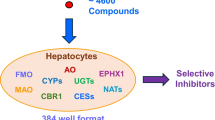Abstract
The knowledge of in vivo biotransformation (e.g., proteolysis) of protein therapeutic candidates reveals structural liabilities that impact stability. This information aids the development and confirmation of ligand-binding assays with the required specificity for bioactive moieties (including intact molecule and metabolites) for appropriate PK profiling. Furthermore, the information can be used for re-engineering of constructs to remove in vivo liabilities in order to design the most stable candidates. We have developed a strategic approach of ligand-binding mass spectrometry (LBMS) to study biotransformation of fusion proteins of peptides fused to human Fc (“peptibodies”) using anti-human Fc immunoaffinity capture followed by tiered mass spectrometric interrogation. LBMS offers the combined power of selectivity of ligand capture with the specificity and detailed molecular-level information of mass spectrometry. In this paper, we demonstrate the preclinical application of LBMS to three peptibodies, AMG531 (romiplostim), AMG195(linear), and AMG195(loop), that target the thrombopoietin receptor. The data show that ligand capture offers excellent sample cleanup and concentration of intact peptibodies and metabolites for subsequent query by matrix-assisted laser desorption ionization time-of-flight mass spectrometry for identification of in vivo proteolytic points. Additional higher-resolution analysis by nanoscale liquid chromatography interfaced with electrospray ionization mass spectrometry is required for identification of heterogeneous metabolites. Five proteolytic points are accurately identified for AMG531 and two for AMG195(linear), while AMG195(loop) is the most stable construct in rats. We recommend the use of LBMS to assess biotransformation and in vivo stability during early preclinical phase development for all novel fusion proteins.







Similar content being viewed by others
References
Cummings SR, San Martin J, McClung MR, Siris ES, Eastell R, Reid IR, et al. Denosumab for prevention of fractures in postmenopausal women with osteoporosis. N Engl J Med. 2009;361(8):756–65.
Banerjee S, Flores-Rozas H. Monoclonal antibodies for targeted therapy in colorectal cancer. Cancer Biol Ther. 2010;9(8):563–71.
Klettner A, Roider J. Treating age-related macular degeneration—interaction of VEGF-antagonists with their target. Mini Rev Med Chem. 2009;9(9):1127–35.
Suzuki T, Ishii-Watabe A, Tada M, Kobayashi T, Kanayasu-Toyoda T, Kawanishi T, et al. Importance of neonatal FcR in regulating the serum half-life of therapeutic proteins containing the Fc domain of human IgG1: a comparative study of the affinity of monoclonal antibodies and Fc-fusion proteins to human neonatal FcR. J Immunol. 2010;184(4):1968–76.
Peters RT, Low SC, Kamphaus GD, Dumont JA, Amari JV, Lu Q, et al. Prolonged activity of factor IX as a monomeric Fc fusion protein. Blood. 2010;115(10):2057–64.
Escher SE, Forssmann U, Frimpong-Boateng A, Adermann K, Vakili J, Sticht H, et al. Functional analysis of chemically synthesized derivatives of the human CC chemokine CCL15/HCC-2, a high affinity CCR1 ligand. J Pept Res. 2004;63(1):36–47.
Pernemalm M, Orre LM, Lengqvist J, Wikstrom P, Lewensohn R, Lehtio J. Evaluation of three principally different intact protein prefractionation methods for plasma biomarker discovery. J Proteome Res. 2008;7(7):2712–22.
Anderson NL, Jackson A, Smith D, Hardie D, Borchers C, Pearson TW. SISCAPA peptide enrichment on magnetic beads using an in-line bead trap device. Mol Cell Proteomics. 2009;8(5):995–1005.
Bandow JE. Comparison of protein enrichment strategies for proteome analysis of plasma. Proteomics. 2010;10(7):1416–25.
Wang H, Hanash S. Electrospray mass spectrometry for quantitative plasma proteome analysis. Meth Mol Biol. 2009;564:227–42.
Wang H, Hanash S. Intact-protein based sample preparation strategies for proteome analysis in combination with mass spectrometry. Mass Spectrom Rev. 2005;24(3):413–26.
Lu Q, Zheng X, McIntosh T, Davis H, Nemeth JF, Pendley C, et al. Development of different analysis platforms with LC-MS for pharmacokinetic studies of protein drugs. Anal Chem. 2009;81(21):8715–23.
Molineux G, Newland A. Development of romiplostim for the treatment of patients with chronic immune thrombocytopenia: from bench to bedside. Br J Haematol. 2010;17:1365–2141.
Cersosimo RJ. Romiplostim in chronic immune thrombocytopenic purpura. Clin Ther. 2009;31(9):1887–907.
Nedelkov D. Mass spectrometry-based immunoassays for the next phase of clinical applications. Expert Rev Proteomics. 2006;3(6):631–40.
Acknowledgments
We would like to thank the following Amgen colleagues: Yow-Ming Wang and Graham Molineux for insightful discussions and critical review of this manuscript and Marcus Soto, Stan Mallard, Tian Wang, Han Gunn, and Teresa Wong for their contributions to the preclinical studies.
Author information
Authors and Affiliations
Corresponding author
Rights and permissions
About this article
Cite this article
Hall, M.P., Gegg, C., Walker, K. et al. Ligand-Binding Mass Spectrometry to Study Biotransformation of Fusion Protein Drugs and Guide Immunoassay Development: Strategic Approach and Application to Peptibodies Targeting the Thrombopoietin Receptor. AAPS J 12, 576–585 (2010). https://doi.org/10.1208/s12248-010-9218-9
Received:
Accepted:
Published:
Issue Date:
DOI: https://doi.org/10.1208/s12248-010-9218-9




